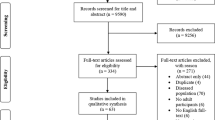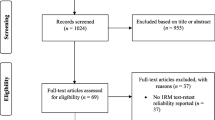Abstract
Background and aims: While the standardized lower extremity physical performance battery (LEPPB) is widely used to measure lower body functional limitation, no corresponding measure has been developed for upper body functional limitation. We combined three standard measures (William’s Hand Test, Hand Signature, Functional Reach) to develop an upper extremity physical performance battery (UEPPB) analogous to the LEPPB, and examined its validity. Methods: We used baseline data from a community-dwelling cohort of 749 Mexican American and European American elders and combined times to complete the William’s Hand Board, Hand Signature, and distance on Functional Reach into a single composite measure, using scoring methods analogous to those for the LEPPB. We summarize concurrent, discriminant, and construct validity evidence for the UEPPB, based on observed associations with established measures of physical functional limitation, disability, and dependence. Results: All correlations were in the expected direction. Shared variance with self-reported upper and lower extremity functional limitation was 10 and 5%, respectively, and with self-reported ADL disability, ADL dependency, and IADL dependency it was 32, 26, and 31%, respectively. In multivariate models of self-reported and performance-based disability and dependency, the UEPPB and LEPPB made significant, independent contributions and, net of contextual variables (age, sex, ethnic group, education, income) explained 4 to 10% of the variance in disability and dependency. Conclusions: The UEPPB is a valid performance-based measure of upper extremity functional limitation and makes an independent contribution beyond LEPPB in explaining disability and dependence.
Similar content being viewed by others
References
U.S. Bureau of the Census. Sixty-Five Plus in America. Washington, DC: U.S. Government Policy Office, 1992: 23–178.
U.S. Bureau of the Census. Census Brief: Disabilities Affect One-Fifth of the Americans. (CENBR), Washington, DC: U.S. Government Policy Office, 1997: 97–5.
Nagi SZ. An epidemiology of disability among adults in the United States. Milbank Q 1976; 54: 439–67.
Verbrugge LM, Jette AM. The disablement process. Soc Sci Med 1994; 38: 1–4.
Institute of Medicine Committee on a National Agenda for Prevention of Disabilities. Disability in America: towards a national agenda for prevention. In Pope M, Taylor AR, eds. Washington, DC: Natl Acad Press 1991: 76–108.
Guralnik JM, Simonsick EM, Ferrucci L, et al. A short physical performance battery assessing lower extremity function: association with self-reported disability and prediction of mortality and nursing home admission. J Gerontol 1994; 49: M85–94.
Hazuda HP, Haffner SM, Stern MP, Eifler CW. Effects of acculturation and socioeconomic status on obesity and diabetes in Mexican Americans: the San Antonio Heart Study. Am J Epidemiol 1988; 128: 1289–301.
Stern MP, Rosenthal M, Haffner SM, et al. Sex difference in the effects of sociocultural status on diabetes and cardiovascular risk factors in Mexican Americans: the San Antonio Heart Study. Am J Epidemiol 1984; 120: 834–51.
Dawber TR. The Framingham Study: The Epidemiology of Atherosclerotic Disease. Harvard University Press, 1980.
Hazuda HP, Comeaux PJ, Stern MP, et al. A comparison of three indicators for identifying Mexican Americans in epidemiologic research: methodological findings in the San Antonio Heart Study. Am J Epidemiol 1986; 123: 96–112.
Branch LG, Katz S, Kniepman K, Papsidero JA. A prospective study of functional status among community elders. Am J Public Health 1984; 74: 266–8.
Fillenbaum GG. Validity and reliability of the Multidimensional Functional Assessment Questionnaire, Multidimensional Functional Assessment: the OARS Methodology. Durham, NC: Duke University Center for the Study of Aging and Human Development, 1978–25.
Mahurin RK, DeBettignies BH, Pirozzolo FJ. Structured assessment of independent living skills: preliminary report of a performance measure of functional abilities in dementia. J Gerontol 1991; 46: P58–61.
Cornell JE, Lichtenstein MJ, Hazuda HP. Performance-based ADL/IADL assessment: a second-order confirmatory factor analysis. Gerontologist 1997; 37 (Special Issue): 330.
Espino DV, Lichtenstein MJ, Palmer RF, Hazuda HP. Ethnic differences in mini-mental state examination (MMSE) scores: where you live makes a difference. J Am Geriatr Soc 2001; 49: 538–48.
Berkman LF, Seeman TE, Albert M, et al. High, usual and impaired functioning in community-dwelling older men and women: findings from the MacArthur Foundation Research Network on Successful Aging. J Clin Epidemiol 1993; 46: 1129–40.
Williams ME, Hadler NM, Earp JAL. Manual ability as a marker of dependency in geriatric women. J Chronic Dis 1982; 35: 115–22.
Williams ME, Gaylord SA, McGaghie WC. Timed manual performance in a community elderly population. J Am Geriatr Soc 1990; 38: 1120–6.
Duncan PW, Weiner DK, Chandler J, Studenski S. Functional Reach: a new clinical measure of balance. J Gerontol 1990; 45: M192–7.
Duncan PW, Studenski SA, Chandler J, Prescott B. Functional Reach: predictive validity in a sample of elderly male veterans. J Gerontol 1992; 47: M93–8.
Cronbach LJ. Coefficient alpha and the internal structure of tests. Psychometrika 1951: 294–334.
SAS User’s Guide: Basics, 2nd ed. Cary, NC: SAS Institute Inc., 1985.
Simonsick E, Kasper J, Guralnik J, et al. Severity of upper and lower extremity functional limitation: scale development and validation with self report and performance-based measures of physical function. J Gerontol 2001; 56B: S10–9.
Haley SM, Jette AM, Coster WJ, et al. Late life function and disability instrument: II. Development and evaluation of the function component. J Gerontol 2002; 571: M217–22.
Reuben DB, Valle LA, Hays RD, Siu AL. Measuring physical function in community-dwelling older persons: a comparison of self-administered and performance-based measures. J Am Geriatr Soc 1995; 43: 17–22.
Kempen GI, Van Heuvelen MJ, van den Brink RH, et al. Factors affecting contrasting results between self-reported and performance-based levels of physical limitation. Age Ageing 1996; 25: 458–64.
Author information
Authors and Affiliations
Corresponding author
Rights and permissions
About this article
Cite this article
Hazuda, H.P., Dhanda, R., Owen, S.V. et al. Development and validation of a performance-based measure of upper extremity functional limitation. Aging Clin Exp Res 17, 394–401 (2005). https://doi.org/10.1007/BF03324629
Received:
Accepted:
Published:
Issue Date:
DOI: https://doi.org/10.1007/BF03324629




